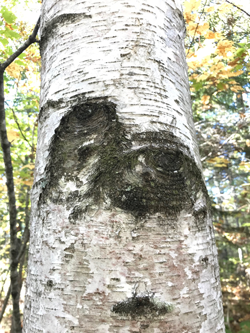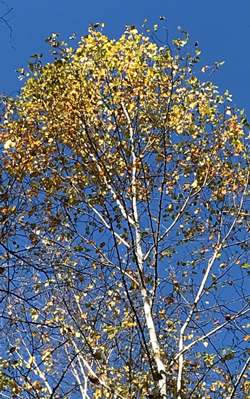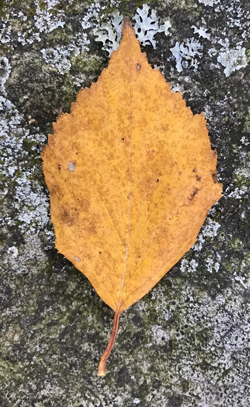 Eyes of the Forest: Birches
Long ago, when I was very young and going out to explore the woods, I was told by a favorite Auntie that I should never feel alone on my outdoor adventures for the eyes of the forest were always looking out for me... I just needed to look to the birches.

Look at the photo.
- Do you see the off-set "eyes" of the birch?
- Do you see a "mouth" below and thin branch along the left side of the trunk as if the birch is scratching its "head"?
- What else does your very creative imagination cause you to see? (It is like seeing images in clouds... have fun with this on your next walk in the woods!)
- What do you think causes the "eyes" and "mouths" to form?
|
Birches are beautiful year round and especially so on deep blue-sky autumn days when birch leaves seem to glow their brightest.

Birches are associated with autumn for their beautiful golden and bronze foliage and, as told in folklore, for being the source of witches' brooms. Birches are also associated with springtime because they are among the first trees to put out new leaves - newly unfurled as a vivid light green on reddish-purple stems and twigs, then maturing to a dark green within a few weeks.
Look for the catkins along with the new leaves come springtime and you will notice two types - the drooping male flower, and the shorter upright female flower - both on the same tree. Birches are monoecious, they have both male and female flowers on each tree. Wind carries the pollen from the male flowers to the female flowers. Once pollinated the female catkins enlarge and droop with their hundreds of mature and ready-for-flight winged seeds. And here again the wind helps out, lifting and scattering the tiny seeds away from the parent tree. Most of the million or so seeds a mature produces will become food for birds and animals. Only a few of the seeds will ever become a mature tree.
|
Interesting Facts
- The "eyes" of birches form naturally when the lower branches die and drop off the trunk. What you are seeing is the branch scar.
- Birches improve the soil through their roots nutrient producing partnership with a variety of fungus, and their seasonal dropping of leaves which, as they decay, add nutrients back to the soil and so available to other plants.
- Birch is a name that originates from "bhereg," meaning "to shine bright white."
- Birch wood is straight grained and strong and is turned on lathes to make handles and spools, and was traditionally used to make toys and cradles.
- Birch wood was also traditionally used to smoke herring and ham.
- Birch sap is still used traditionally used as a skin soother and fermented to make birch wine.
- Birch bark can be twisted into short ropes and lighted as a small torch or candle.
- Birches are considered a pioneer species - they will grow in after fires and on scoured land before other trees are established, yet for all this toughness they are not tolerant of pollution.

Activities for Children and the Young at Heart
- Learn about the different kinds (species) of birch in Maine, how to tell them apart, and more about their traditional and current uses in the birches section of Forest Trees of Maine. See complete handbook by the Maine Forest Service.
- Can you identify the pictured birch leaf by using the Forest Trees of Maine?
- Go on a birch discovery hike. Observe where you see them - is it in any special repeating kind of habitat? Do you notice any birds or animals around the birches? What species do you most often see? Do you see any fungus growing on or around the birches?
- What is the greatest trunk girth (circumference) you observe? Take a tape measure with you and measure the trees at the same height - using your body as the reference point. Foresters always measure tree girth at breast height.
- Do birches get as tall and as large in trunk girth as the other trees in the forest? Why do you think this is so?
- Go on a lumber exploration. Visit a lumber yard or store that sells lumber and see how many kinds of wood they sell. Is birch wood among them? Can you find any dowels? What are they made of?
- Try a birch wood product hunt. Look around your house. Are there any wood products? How many are made of birch wood?
- Make a drawing or painting, or take a photo, of your favorite birch tree.
- Visit your favorite birches year-round, if you can, and be sure to plan a springtime visit to look for the newly unfurling leaves, the maturing catkins, and to see who else is visiting or emerging from the birches.
|
Share Nature Note with your friends, family, teachers, scouts, and anyone you think might be interested. Here is how they can sign up for a free subscription:
Read back issues online.
Suggest a topic by email; put Nature Note in Subject line and email Jocelyn Hubbell.
|